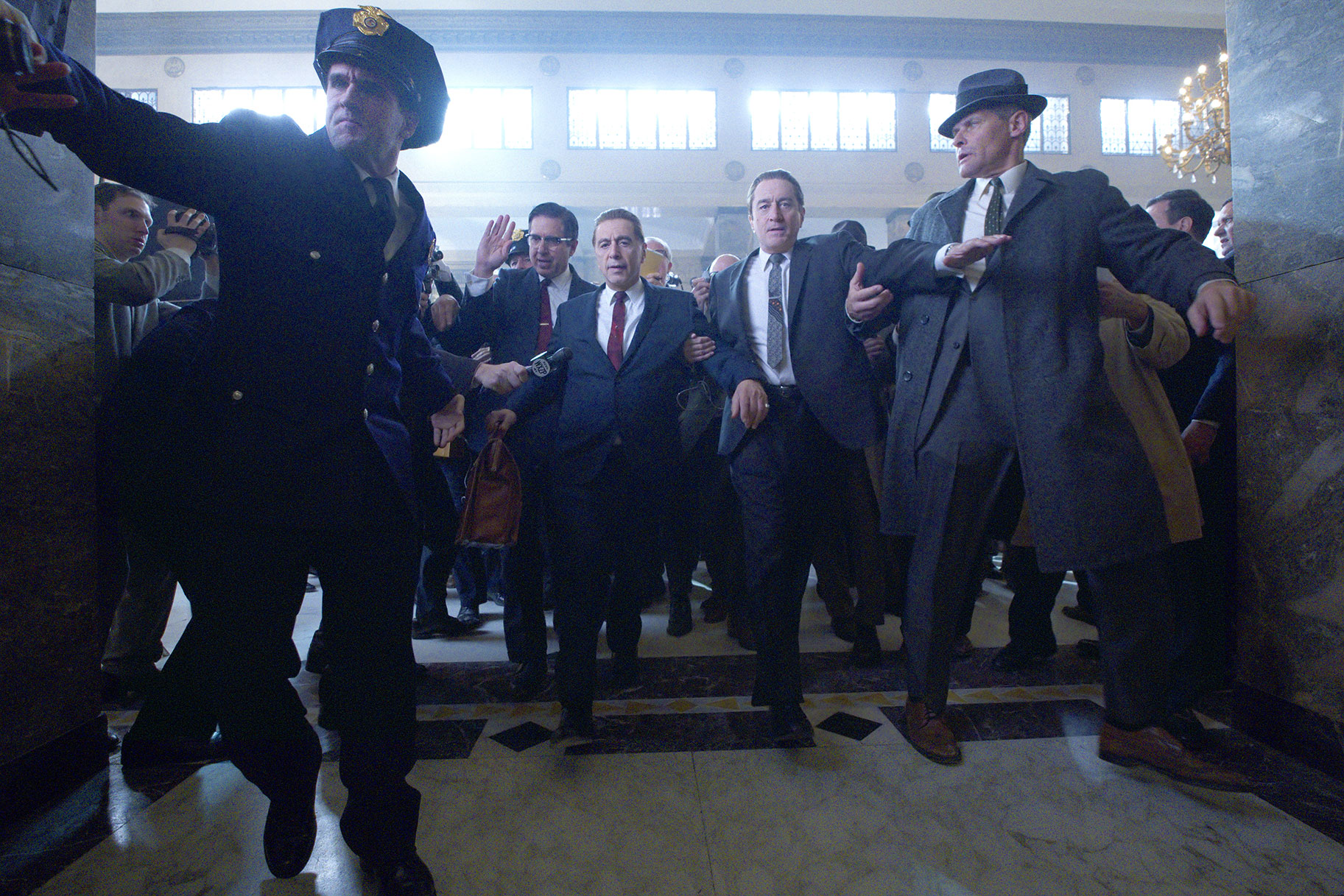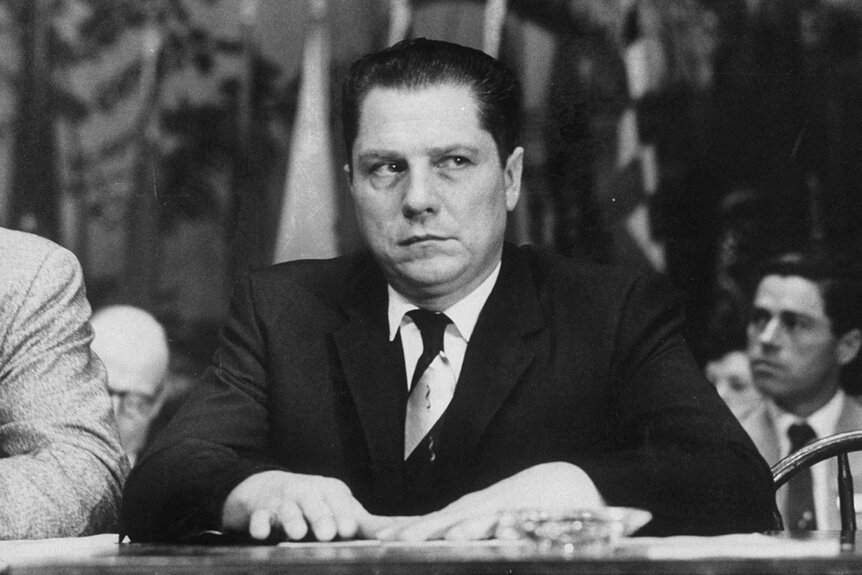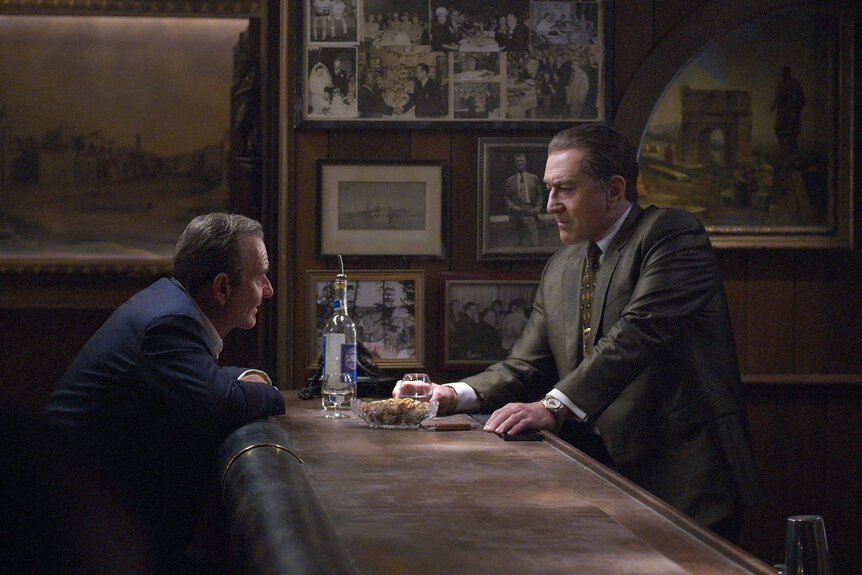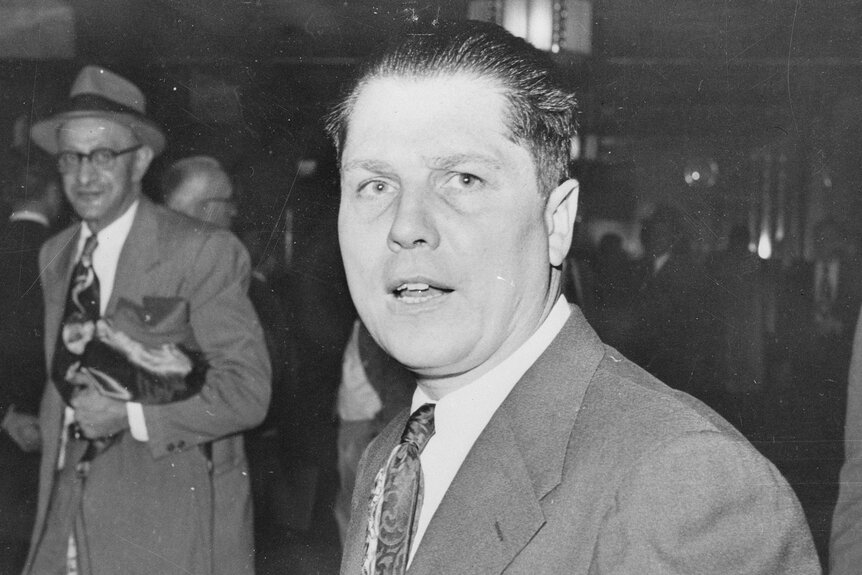Create a free profile to get unlimited access to exclusive videos, breaking news, sweepstakes, and more!
Robert De Niro's 'The Irishman' Is A Real-Life Mobster — Here's The True Story Of Frank Sheeran
Frank "The Irishman" Sheeran is allegedly the man behind gangster Jimmy Hoffa's murder.

Jimmy Hoffa and his trusted assassin, Frank Sheeran, met over the telephone.
Sheeran remembered the moment he was introduced to the union bigshot. It was his mafioso mentor, Russell ‘McGee” Bufalino, who handed over the receiver.
“I heard you paint houses,” chirped Hoffa, skipping the pleasantries.
Sheeran stammered back: “Y-y-yeah, and I d-do my own carpentry work, too.”
But Frank Sheeran wasn’t a construction worker. And painting houses was actually code for blood spatter on walls caused by committing executions.
The fact was, Sheeran was a WWII veteran who would soon become a rising star in Philadelphia’s underworld by working as a hitman.
The almost innocuous moniker he was given, “The Irishman,” spoke to his dad’s Dublin roots (his mother was Swedish), and it cloaked his executioner rep where he would go on to rack up at least 25 murders and was accused by former U.S. Attorney General Rudy Giuliani of being one of two non-Italians granted membership in La Cosa Nostra’s ruling commission.
Sheeran’s life story is the focus of Martin Scorsese’s biopic, “The Irishman,” loosely based on the 2004 book, “I Heard You Paint Fences,” which recently premiered at the 57th annual The New York Film Festival. Robert De Niro is playing the lead role of Sheeran, cast opposite Al Pacino as Hoffa, the union boss whose July 30, 1975 disappearance became one of America’s greatest whodunits.
Sheeran reportedly claimed credit for killing Hoffa.
The tale is packed with so much intrigue that it has attracted a strong backlash by some who have doubts that it was Sheeran who actually pulled the fateful trigger.
So, who's the real Frank Sheeran?
Sheeran's Early Life, Reared On Mean Philadelphia Streets
In the book, written by Charles Brandt, Sheeran unpacks his life story over a series of confessional interviews.
Sheeran came up through the streets of Philadelphia a devout Catholic, but also a scrappy brawler who was pushed by his father to challenge kids to street bouts to feed his father’s drinking habit.
“My father did like his beer,” Sheeran said, reflecting on how Tom, who worked as a steelworker, rode him to collect dime coin winnings.
Like many Americans, Sheeran found what work he could in the days before the Great Depression. He took odd jobs like bagging groceries, caddying at golf courses, and assisting a carnival barker outside burlesque tents.
He then entered dance competitions and took home second prize in the fox-trot competition in 1939. Sheeran took first in a jitterbug dance years later. He would go on to give dance lessons, which amounted to $45 a week in take-home pay, which was more money than his father’s take-home steel mill pay.
The young man left civilian life in 1941 to enlist in the U.S. Army. It was during his time on the battlefield as an infantry soldier that Sheeran was inspired by the fiery speeches of General George Patton and hardened by death’s presence.
“Once the shooting starts it goes way,” Sheeran said. “You just do what you have to do.”
Adjusting back to life in Philadelphia was tough for the hardened veteran. He tried playing it straight. He married his sweetheart and they tried to raise a family on a union truck driver's wages for a supermarket outfit known as Food Fair.
But Sheeran would soon be lured into the quick buck, and sought out a lawless life after connecting with Russell “McGee” Bufalino.
From Hauling Meat to Italian Mob Hitman
It was 1955, and Sheeran was hauling meat in upstate New York when “this short old Italian guy walked up my truck and said, ‘Can I give you a hand, kiddo?’” Sheeran told Brandt.
That man was Bufalino, a reputed mob boss whose territory included upstate Pennsylvania, parts of New York, New Jersey, and Florida. The two shared instant chemistry.
Besides Hoffa, Bufalino was one of two men Sheeran came to respect. While the New York City-based Bufalino wasn’t a card-carrying member of New York’s five families, Sheeran emphasized “all the families came to him for advice on everything.”
He described Bufalino in Brandt’s book “as one of the biggest bosses in their business, and I was his friend.”
Sheeran first cut his La Cosa Nostra teeth as a driver, often ferrying Bufalino to secret sit-downs. But the rote days on the road wore on Sheeran and Bufalino vowed, “You ain’t going to be driving a truck forever, my Irishman.”
Bufalino made good on his promise.
The trained killer was propositioned by an overzealous crook named Whispers DiTullio to burn down Cadillac Linen Service, a factory that supplied table covers and napkins for restaurants. He had offered Sheeran thousands in cash to take the job. But the Italian and Jewish mob each had financial stakes in it.
Before he set fire to the factory, Sheeran was called to answer to a big boss named Angelo Bruno at an Italian restaurant in Midtown Manhattan. Bruno quickly made Sheeran aware that he would have made a grave mistake if he had gone through with the arson.
To make it right, Sheeran was ordered to kill Whispers.
“It’s your responsibility to take care of this matter tomorrow morning. That’s the chance you get. Capish,” Sheeran said Bruno told him.
Whispers was discovered dead the next day, shot at close range with a .32 caliber gun. Sheeran read the headline and told himself, “That could have been me.”
Sheeran would go on to become a high-ranking union official as we all as a mob enforcer who would “straighten out” whoever he was told, allegedly having a hand in the infamous rub out of Colombo mobster Joey “Crazy Joe” Gallo outside Umberto’s Clam House in Manhattan’s Little Italy back in 1972.
Becoming Jimmy Hoffa’s Most Trusted Muscle
The phone call introduction with Jimmy Hoffa formed a tight bond. Hoffa was a living legend and president of the International Brotherhood of Teamsters. Like Bufalino, Sheeran became one of Hoffa's closest confidants.
The union represented more than 2 million workers and commanded a $2 billion pension fund.
But the Teamsters at that time were dogged by criminal elements who used all sorts of underhanded methods to push their causes. Sheeran became a reliable street soldier in these less savory transactions.
When Robert Kennedy took over as the country’s attorney general, it was no longer mob business as usual. Kennedy set his sights directly on the Teamsters. That meant confronting its leader, Hoffa.
Before his assassination, Kennedy likened Hoffa’s leadership as “a superpower in this country — a power greater than the people and greater than the government.” According to the book, Hoffa and Kennedy once met in private and Hoffa let him know, “I do to others what they do to me, only worse.”
In 1967, Hoffa was sent to Lewisburg Penitentiary in Union County, Pennsylvania, for jury tampering, fraud, and bribery. He would only serve four and a half years of his 11-year sentence because then-President Richard Nixon granted him clemency.
Hoffa’s paroled freedom came in 1971 but with a catch: He was forbidden to partake in union business until 1980.
Jimmy Hoffa's Downfall
Once freed, the former union boss waged a public war against the federal government for what he perceived was overstepping its bounds by preventing him from taking part in his prized union.
Hoffa vowed to reclaim the top Teamsters perch, which had been occupied by his replacement, Frank Fitzsimmons. Hoffa also launched a well-publicized civil case against the U.S. government, which was circulating through the U.S. Court of Appeals and involved subpoenaing Teamsters' records.
While he was fighting in court against the government, Hoffa refused to give up the pursuit for the Teamsters presidency, despite numerous pleas to do so.
It became personal, as Fitzsimmons, who was less bombastic and more about golf and beer, was a former loyalist who liked the job. The two were now adversaries fighting for the same top post.
Sheeran told Brandt that Hoffa’s unchecked ego ultimately led to his death. Hoffa, he said, “kept sailing into the storm.”
Allegedly, Bufalino point-blank informed Hoffa “certain people” were happy with Fitzsimmons and that he should get out of the Teamsters race. When Hoffa refused, Bufalino supposedly told Sheeran,“Talk to your friend. Tell him what it is.”
To Sheeran, that was “as good as a death threat.”
Hit Put Out On The Irishman's Friend
By the mid-1970s, Jimmy Hoffa had begun referring to himself in the third person as “Hoffa,” and he refused to listen to demands by his mafia friends to stand down on his bid for the Teamsters presidency.
“Nobody scares Hoffa,” he supposedly told Sheeran after his loyal soldier warned him that their friends wanted him to stand down. “I’m going after Fitz, and I’m going to win this election.”
Already, Bufalino had made it clear that Hoffa’s life depended on him bowing out of the race. “Russ himself told me to tell you what it is,” Sheeran said he told Hoffa.
“They wouldn’t dare,” Hoffa thundered back.
But the Irishman would soon allegedly get the order to pick up his paintbrush. “The decision was made to paint the house and that was it,” he told Brandt.
Sheeran reportedly told Brandt the following story of Hoffa's murder:
On July 30, 1975, weeks after Fitzsimmon’s son’s car exploded outside of a Detroit bar, Hoffa drove from his Lake Orion, Michigan summer cottage to attend a planned meeting with Sheeran and Bufalino at The Machus Red Fox Restaurant located in the Detroit suburb of Bloomfield Township.
They would congregate at 2:30 p.m. Hoffa thought he was sitting with Bufalino and another east coast heavyweight Genovese captain named Anthony “Tony Pro” Provenzano to make peace, Sheeran claimed.
Sheeran was brought in to make Hoffa feel at ease. Also summoned to serve as “bait” was Hoffa’s foster son, Chuckie O’Brien. He was tasked with driving Hoffa to a home “a few miles away” from the restaurant.
Provenzano wasn’t even in Michigan. Instead, he had one of his men named Salvatore "Sally Bugs" Briguglio serve as his stand-in. The men got into a maroon Mercury car owned by the son of mobster Anthony “Tony Jack” Giacalone.
As they arrived late to the restaurant, Hoffa was “showing rage in his eyes,” Sheeran said.
“What the f--k are you doing here? Who the f--k invited you?" Hoffa hollered at his foster son.
He then asked who Sally Bugs was.
“I’m with Tony Pro,” Bugs said. “His friend wanted to be at the thing. They’re at the house waiting.”
Hoffa bought the story and believed that Bufalino was waiting for him at a house with Provenzano.
“If there was going to be any violence, anything unnatural, Russell would not be there,” Sheeran explained of Hoffa's thinking.
Hoffa got into the car and they drove to the home that was picked out beforehand. They exited the car and walked into the home. The second Hoffa saw that it was empty with no sign of Bufalino or Tony Pro to greet him, “he knew right away what it was,” Sheeran said.
“He turned fast, still thinking we were together on the thing, that I was his backup,” Sheeran explained.
But Sheeran had his “piece” in his hand and as Hoffa attempted to reach for the knob of the door to get out “Hoffa got shot twice at a decent range — not too close or the paint splatters back at you — in the back of the head behind his right ear."
“My friend didn’t suffer," Sheeran claimed.
Sheeran fled the scene to an airport where he hopped a plane to Port Clinton, Ohio and reunited with Bufalino.
“Anyway, I hope you had a pleasant flight my Irish friend,” his mentor told him as they sped away.
Greatest Whodunit Of All-Time
The vanishing of Jimmy Hoffa captivated law enforcement for decades. The body's whereabouts became the stuff of legend.
Tips and theories had Hoffa being buried at New York Giants Stadium.
Sheeran, who wasn’t certain of what happened to Hoffa’s body, believes it was taken to a local meatpacking plant belonging to an old-timer named Pete Vitale. The plant had an industrial incinerator “where a body could be burned up.”
Sheeran claimed Bufalino informed him that Hoffa went to a funeral parlor and then to a crematorium. But Sheeran had his doubts, noting in the book, “This detail was none of my business and anybody who says they know more than this — except for the cleaner who is still alive — is making a sick joke.”
Controversy swirled soon after Sheeran claimed he made Hoffa disappear.
First there were issues with the crime scene.
Law enforcement officers back in 2005 returned to the Bloomfield Township home where Sheeran claims to have ambushed Hoffa.
Floorboards were ripped up and forensically tested following a Fox News crew's private testing revealing blood drops in the corridor and foyer.
The results were tested at an FBI crime lab and it was concluded they were human blood, but didn't appear to be Hoffa's, according to multiple reports at the time.
In 2008, Brandt gave a video of Sheeran confessing to killing Hoffa to FBI agent and lead Hoffa investigator at the time, Andrew Sluss. But after watching it multiple times, he wasn't sold.
“Seeing is believing, except in this case, then seeing becomes disbelieving,” Sluss told The New York Review Of Books. “The video I saw of Sheeran was a laughable, sad, desperate attempt to create a record.”
Author David Moldea, whose deep interviews with mob figures and various Hoffa investigators trying to crack the case culminated in "The Hoffa Wars," is also skeptical of much of Sheeran's admissions.
Moldea concedes Sheeran may have flown to Michigan and helped get Hoffa to lay down his guard and get in the car for the venue switch from the restaurant to the house. But Moldea suspects “Sally Bugs” Briguglio, not Sheeran, shot Hoffa and that his body was disposed of at a New Jersey dump.
“This is a one-source story about a pathological liar,” Moldea told The New York Post.
At a 2014 dinner where Rober De Niro and the writer met, Moldea said he insisted Sheeran's story doesn't wash.
“De Niro had a lot of pride that he is doing the real story,” Moldea said. “I told him that he’s been conned.”
Sheeran was always eyed by authorities for Hoffa's disappearance, but after years of trying to get him to talk and failing, he evaded being convicted for the crime.
But “The Irishman” didn’t sail away scot-free.
In 1982, with Hoffa having been declared officially dead, the Department of Labor and the FBI and the state of Delaware brought a pair of cases against Sheeran.
One of them involved Sheeran, who had become president of Teamster Local 326 in Wilmington, Delaware, threatening to "blow up" a crane company based in Newark, Delaware, according to court documents. In the book, Sheeran said he was caught after "picking up" dynamite from a government contracted ammunition manufacturer.
Sheeran was also convicted of criminal solicitation for making physical threats against the same crane company's official, according to court documents. These happened to be captured by an FBI turncoat wearing a "wired body recorder." The fellow union member recorded Sheeran saying, “Break both of his legs. I want him laid up. I want him to go to a hospital,” Sheeran admitted in the book. “The feds got me for that one in a state trial in Delaware.”
The Irishman ended up being sentenced to 32 years in prison. He would be released in 1995, serving less than half of the sentence, due to suffering a series of physical ailments that finally left him confined to a wheelchair.
His favored mentor, Bufalino, also went to prison for extortion and was released only to return for threatening to murder a rival. At 90, Bufalino died in prison from stroke complications.
In 2002, after making some last-ditch attempts to get Sheeran to confess, the FBI closed its almost three-decade pursuit on Hoffa’s case. The bureau turned over its 16,000-page file to the Michigan district attorney and 1,330 pages of that file were released publicly. The Michigan DA ultimately closed the case as well.
Sheeran passed away from cancer in 2003.
In one of his final interviews before he died, the bedridden Sheeran seemed to lose the Irishman bravado. All that was left appeared to be a remorseful man. "If I did all the things they allege I did and I had to do them over again I would not do them," he said.




























